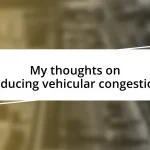Key takeaways:
- Urban bike lanes enhance safety, encourage cycling, and promote a healthier lifestyle, ultimately benefiting community well-being.
- Challenges in implementing bike lanes include opposition from motorists and businesses, funding issues, and political support for road expansions over bike infrastructure.
- Maintaining bike lanes is crucial; poorly maintained paths deter cyclists and undermine the push for sustainable transportation.

Understanding urban bike lanes importance
Urban bike lanes play a crucial role in promoting sustainable transportation. I remember the first time I tried cycling in a city without dedicated lanes; it was chaotic and nerve-wracking. Have you ever felt that pulse of anxiety when a car zooms by just inches away? It’s alarming and, frankly, discouraging for anyone considering bike riding.
When bike lanes are integrated into urban planning, they not only enhance safety but also encourage more people to cycle, fostering a healthier lifestyle. I can’t help but think about how many times I’ve seen friends transformed into avid cyclists simply because they felt safe to ride. Doesn’t it make you wonder how many more people would hop on their bikes if they had secure routes?
Moreover, the presence of bike lanes can significantly reduce traffic congestion and pollution. I vividly recall a day when I cycled down a busy street with a dedicated lane; it was freeing. Isn’t it remarkable how a single lane can bring a sense of community to a usually car-dominated space? Urban bike lanes are not just paths; they are vital arteries for healthier cities and happier inhabitants.

Challenges of implementing bike lanes
One of the biggest challenges in implementing bike lanes is the pushback from motorists and businesses concerned about lost parking spaces. I remember a heated debate in my own neighborhood when a proposal for bike lanes came up; the tension was palpable. Isn’t it interesting how proposals that aim to enhance one mode of transportation can threaten another?
Another significant hurdle is the need for funding and political support. Often, I’ve seen cities prioritize road expansions for cars over bike infrastructure due to perceived public demand. But when I think about the future of urban mobility, don’t you find it ironic that investing in bike lanes can lead to a more balanced transportation ecosystem?
Lastly, there’s the issue of maintaining the bike lanes once they’re built. In my experience, I’ve noticed that poorly maintained lanes can quickly become a deterrent for cyclists. With potholes and debris littering the path, it makes me question—how can we expect people to choose cycling if their ride feels unsafe?














